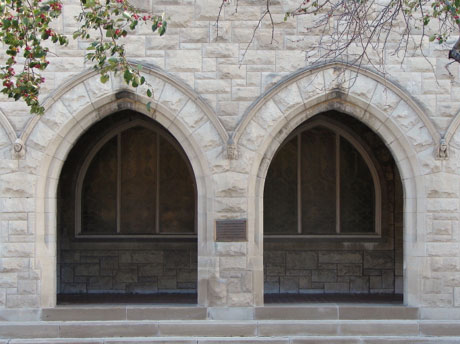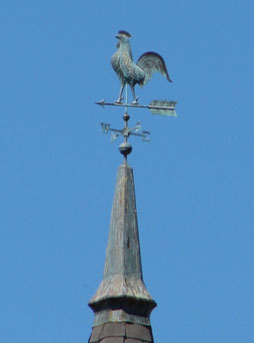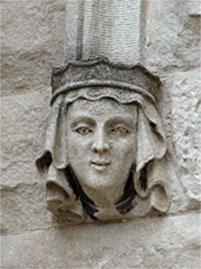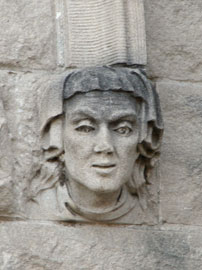32. First Unitarian, 1891
1342 North Astor Street (at Ogden Avenue)
Architects: Ferry and Clas

Many of Milwaukee’s nineteenth century Gothic Revival churches are tall buildings with soaring towers and steeples. Toward the end of the century, architects began to design some churches in the style with much shorter steeples and a more horizontal rather than vertical emphasis. This type of Gothic Revival design became much more common in the early decades of the twentieth century. The church that the partnership of George Ferry (1851-1918) and Alfred Clas (1859-1942) designed for First Unitarian is one of the city’s earliest examples of this new type. Although the roof is steeply pitched, the eaves are quite low and the steeple is less than 100 feet in height.
The exterior of First Unitarian is clad in Bedford limestone quarried in southern Indiana. Most of the city’s masonry churches were of brick up to this time, although stone was becoming more common. Exterior ornamentation is limited to carved stone figures at the ends of the drip moldings above the arched doorways and windows. One of the figures on the west façade depicts Robert Metcalf, a member of the congregation who donated funds for the purchase of the organ.
With seating for about 450 people, the worship space is not large, but the high ceiling provides a feeling of spaciousness. The ceiling reaches a height of 65 feet above the floor at its highest point, with the roof supported by impressive wooden hammerbeam trusses. All of the stained glass windows, of predominantly amber and green tones, consist of geometric patterns rather than depictions of saints or biblical stories.
The partnership of Ferry and Clas was one of the city’s most prominent architectural firms in the 1890s. George Bowman Ferry was born in Massachusetts and studied architecture at the Massachusetts Institute of Technology. This was the first university architecture program in the United States, begun in 1868, just a few years prior to Ferry’s enrollment in 1871. When Ferry moved to Milwaukee in 1881, he would have been one of only a few university-trained architects in the city, with the others being immigrants trained at European universities. It was not until the twentieth century that college architecture programs began to supplant apprenticeship as the typical route into the profession. Alfred C. Clas was born of German immigrant parents in Sauk City, Wisconsin. His architectural training came in the more traditional manner of apprenticeship in architects’ offices, in Milwaukee and briefly in California. The two men had separate offices in Milwaukee prior to the formation of their partnership in 1890.
One of the first commissions to come into the office of Ferry and Clas was the reconstruction of the tower of St. John’s Catholic Cathedral. Also in the early 1890s, the firm won the competition to design Milwaukee’s Central Library. The library is one of the city’s greatest architectural monuments, executed in an ornate Renaissance Revival style. These varied commissions for a classical church tower and library as well as a Gothic Revival church illustrate how a successful architectural firm in this eclectic period had to be fluent in the languages of many different historical revival styles.
A small group of Milwaukee residents founded the city’s First Unitarian Society in 1842, in response to the missionary work of the Rev. Joseph Harrington of the Unitarian Society of Chicago. The Society built its first church the following year, at 2nd Street and what is now Wisconsin Avenue. This was a wooden building in the Greek Revival style. The Society lost that church to foreclosure in 1850, due to declining membership and financial difficulties, and the building was sold to St. James Episcopal Church. After a dormant period of several years, a revived Unitarian congregation built a new church in 1857, a few blocks from the location of the present church on the city’s East Side. Work on the third and present building began in the spring of 1891, with dedication in the following year. George Ferry was a member of the Unitarian Church and is believed to have been the primary designer of the building.
It was perhaps with some optimism that the founders of this church named it First Unitarian, for there has never been a second church of this denomination in the city. However, the rapid growth of suburban communities after World War II led to the founding of two new Unitarian congregations in the Milwaukee metropolitan area in the early 1960s: the Unitarian Church West in Brookfield and the Unitarian Church North in Mequon. There is also a fourth Unitarian congregation, founded in 1877 in the village of Mukwonago, which relocated to the western suburb of Waukesha in 2012.
Sources:
“Alfred C. Clas is Dead at 82, Rites Friday,” Milwaukee Sentinel, July 9, 1942, page 4A, column 5.
Historical Sketch of the First Unitarian Church of Milwaukee. First Unitarian Church, 1892.
Kassowitz, Karl E. The Rooster on the Roof. First Unitarian Society of Milwaukee, 1967.
“Noted Designer Passes Away” (obituary of George B. Ferry), Milwaukee Journal, January 29, 1918, page 1, column 7.
Wietczykowski, Mary Ellen, and John Thiel. First Unitarian Church. Historic American Buildings Survey, 1970. HABS No. WI-267.




